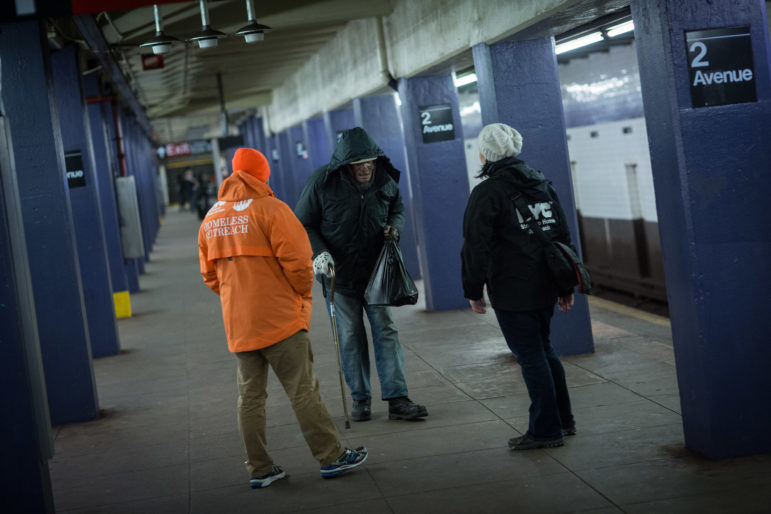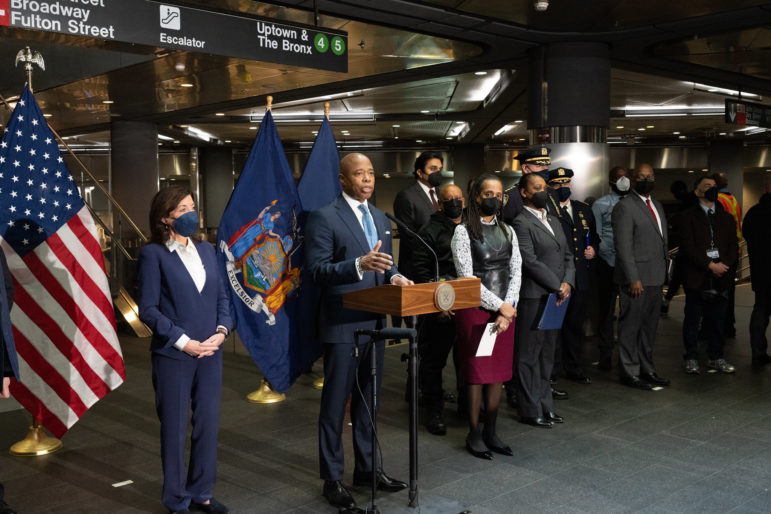More than 700 people staying on trains or at end-of-line stations accepted placement in a temporary shelter in the first two months of Adams’ so-called “Subway Safety Plan,” according to agency data, but Jenkins would not say how many stick around.

Michael Appleton/Mayoral Photography Office
Homeless outreach workers in the subway system in 2016.The head of New York City’s homeless services hailed a spending boost for Mayor Eric Adams’ signature subway outreach and removal initiative at a Council budget hearing Friday, but dodged a question about how many riders who agree to go to a shelter actually stay there.
Department of Social Services (DSS) Commissioner Gary Jenkins faced few probing queries from members of the Finance and General Welfare Committees as he summarized the proposed $2.4 billion Homeless Services Executive Budget, with much of the focus on $171.3 million to bolster Adams’ strategy for driving unsheltered New Yorkers off the trains.
More than 700 people staying on trains or at end-of-line stations accepted placement in a temporary shelter in the first two months of Adams’ so-called “Subway Safety Plan,” according to agency data, but Jenkins would not say how many stick around.
“Our main focus and goal is … garnering that trust with them because once they come in, we consider that a positive because, again, it gives us the opportunity to understand what their circumstances are,” Jenkins said after Finance Committee Chair Justin Brannan asked him how many of the 700 people who agree to a shelter placement return to the streets or secure permanent housing.
The subway plan relies on teams of outreach workers, nurses and mental health specialists to coax people off the trains or to order them hospitalized, as well as cops to crack down on people who lay down on seats and violate other underground rules. Enforcement has so far outpaced the number of people accepting services: In the first month of the initiative, police made 719 arrests, issued 6,828 summonses and ejected nearly 2,000 riders.
Even if someone who accepted a shelter placement ultimately returns to the streets or subways, they’ll now be more aware of their options going forward, Jenkins argued.
“If they do go back out at least now, they’re exposed and they’re aware the services are here and the city is ready and willing and able to provide the services to them,” said Jenkins, who oversees the Department of Homeless Services (DHS).
An official for DHS said the agency does keep track of that “recidivism rate” but spokespeople for the agency did not provide the information when contacted for this story multiple times.
Advocates and policymakers raised similar concerns about a revolving door of shelter placements when the city abruptly moved people from hotels used to reduce the spread of COVID-19 back into group shelters last summer. Many people did not report to the new locations, or left after a short stay.
After ex-Gov. Andrew Cuomo shut down nighttime subways early in the pandemic to prevent homeless New Yorkers from staying on board or in stations, DHS tracked how many people who accepted shelter placement at “end of line” stations actually stayed.
“That’s a key metric they need to be reporting,” said Coalition for the Homeless Policy Director Jacquelyn Simone. “Tracking those metrics could help the administration identify gaps and actually improve the services that are being offered to people.”
Adams has made the effort to move homeless New Yorkers off the streets and subways a core priority since taking office Jan. 1, though his strategies faced some criticism at the hearing Friday.
“They’re experiencing them as violence,” Councilmember Tiffany Cabán told Jenkins Friday during a debate over the term “sweeps” versus the term “clean-up” favored by the city. “I believe there’s dignity in a Housing First approach. Dignity in permanent housing directly from the street.”
Cabán also grilled Jenkins about whether the Adams administration relies on “clinical evidence” to show that enforcement does not harm trust in outreach workers trying to offer services. Jenkins responded that the agency talks with “people with real life experiences, people who were actually homeless or lived in an encampment.”
Unsheltered New Yorkers, their advocates and policymakers also say those efforts—with cops arresting individuals who refuse to leave and Sanitation workers throwing possessions into garbage trucks—simply shift people from one location to another. Statistics provided by the mayor’s office last month show just 39 people accepted a shelter placement after being subjected to one of roughly 700 aboveground encampment sweeps.
“The removal of the encampments was cruel,” said Councilmember Charles Barron at the hearing. “I think it was for Wall Street… so New York City looks better for investors.”
The acceptance rate has been higher for subway outreach: Officials said earlier this month that some 700 people staying on trains and in stations accepted services from city and state workers since the subway safety plan started, though did not provide specifics. Adams unveiled the plan alongside Gov. Kathy Hochul in February, as subway ridership continued to lag well below pre-pandemic levels. MTA surveys have shown that a sizable number of former subway riders say crime and perceived danger have kept them from returning to the rails.

Gov. Hocul’s Office
Gov. Kathy Hochul and Mayor Eric Adams announcing plans for subway policing and homeless outreach in February.
Adams, Jenkins and other DHS officials say the ongoing enforcement component of the “Subway Safety Plan” is accompanied by an “historic” investment in outreach services and Safe Haven and stabilization beds, which eliminate curfews and intake processes, feature fewer restrictions and at times offer more privacy than traditional congregate shelters.
Most street homeless New Yorkers say they have left congregate shelters, according to a survey conducted last year by the Coalition for the Homeless, and many who have talked with City Limits over the past year say they would accept placement in the low-barrier Safe Haven and stabilization shelters if offered.
“We’re really excited with the historic investment that [Adams] placed into our agency as it relates to our homeless population,” Jenkins said Friday.
The Executive Budget for DHS includes about $12 million to fund 20 extra staff positions as well as other outreach efforts, though the exact plans are unclear.
While the Executive Budget for the agency marks a roughly $400 million decrease from the current 2022 fiscal year—largely due to a depletion of COVID-related federal funds—the spending plan would fund the creation of 1,400 new Safe Haven and stabilization beds by the end of next year, officials say.
The number of people using those beds has steadily increased over the past four months as more have come online, according to daily data tracked by City Limits. There were just under 1,500 people in Safe Havens on May 16 compared to 1,162 on Jan. 3, the City Limits tracker shows.
There are now a combined 2,700 Safe Haven and stabilization beds across the city, and just 31 were vacant on May 3, city officials testified at a council hearing earlier this month. The city’s most recent street homeless census counted 2,376 people staying in public spaces, a figure advocates say is a significant undercount.
But the agency could be in for a familiar fight as it seeks to add more shelter capacity.
During the budget hearing, Jenkins told councilmembers that DHS will work closely with community boards across the five boroughs to locate new facilities equitably under the city’s Fair Share law. So far, however, DHS has cancelled plans for two Safe Haven and stabilization sites in Chinatown—one over a union dispute and the other in response to community backlash.
The city does not have to alert communities about new stabilization sites, but does have to provide notice about Safe Havens.
“We’re looking forward to a really good collaborative conversation to ensure we’re meeting our goals and to ensure these really valuable low-barrier beds will be part of those communities,” Jenkins said.
At least one man who accepted shelter placement after being approached by a subway outreach worker has opted not to return to the train, but his journey over the past month has been a bumpy one.
Last month, David Harris, 42, agreed to move into a Bronx hotel referred to as the city’s first “Welcome Center” for street homeless New Yorkers. As City Limits first reported, the hotel, located near major roadways in Morrisania and run by the politically-connected nonprofit Acacia Network, features two-person rooms, each with a television.
Standing outside the building, Harris said he found the location comfortable and thought he could stay “until I get my own place.”
But the “Welcome Center” is designed to function as a temporary waystation for people coming in off the streets. On Sunday, Harris said he had recently moved into another Safe Haven site, this time at a facility across the street from Lincoln Hospital. Adams attended a ribbon-cutting at the new shelter in March.
“There’s a lot of people jammed in at the new one,” Harris told City Limits, adding that about nine other people stayed in the room. “It’s like a dorm.”
The food is good, he said, but compared to the large shared room, the two-person hotel quarters were “a luxury.”
Harris said new roommates seem to arrive and exit after short stays at the facility, but he has decided to stay put because it is the only way he sees landing a permanent apartment.
“I have to stay so I can get my place,” he said.
Forgoing federal funds
The Executive Budget plan includes $12 million to expand outreach efforts at end of line subway stops and to hire 20 new staff members for the shorthanded homeless services agency.
DHS, however, has forfeited $29 million in federal assistance allocated through the American Rescue Plan Act (ARPA) specifically for outreach services, according to a Council analysis.The Adams administration took the $29 million from DHS due to “underspending on street homeless outreach services and low-barrier shelter beds, which did not come online in the timeframe initially expected,” a report prepared by Council’s Finance Division states.
The Executive Budget plan redistributes that money to other agencies, even as DHS pays staff overtime to pitch in on end-of-line subway canvassing.
In recent weeks, DHS has asked staff members to take on extra shifts as part of the “Enhanced End of Line Initiative,” according to an internal email shared with City Limits. Staff who agree to canvas the last stops on the A, E, F, J, Q, R, 1 and 3 trains from 5 a.m. to 9 a.m. can earn overtime, and some top agency officials have participated in the overnight and early morning efforts.
None of the councilmembers present at the hearing asked about the lost federal money, but a DHS spokesperson told City Limits that the agency had anticipated spending more on outreach last year. DHS said the baselined city spending will ensure that the funds remain ongoing.
Comptroller Brad Lander said his office will monitor the use of federal funds for homeless services, particularly when it comes to a commitment he and Adams made to reform a glacial payment process for nonprofit contractors.
“DHS has a few more fiscal years to use their allocated federal stimulus dollars, and it should be every city agency’s priority to spend these time-limited funds wisely,” Lander said in a statement. “New Yorkers deserve to know why the city plans to reallocate DHS’ stimulus dollars budgeted for homelessness outreach into other agencies when we are facing an acute, ongoing crisis.”







